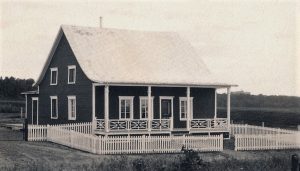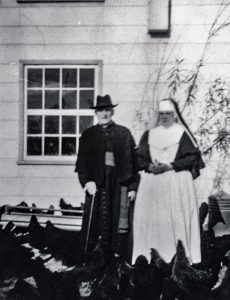Living quarters at Saint-Joseph farm
The Sisters’ house, on the right (white) and the farmer’s house, Mr. Simard, on the left (black), on Saint-Joseph farm. Beehives can be seen in front of the white house
Circa 1955
SNDBC Archives

Simard house, 1954. SNDBC Archives
When the Congregation acquired Saint-Joseph farm, it already included a house. Built in 1855, it was in poor condition; it was entirely renovated, solidified, and refreshed. When Victorien Simard became the farm’s resident farmer in 1937, he moved in to the house. The house was named after him, maison Simard. He lived there with his wife and children, until the house was demolished in 1980, at which time he moved into a mobile home on the farm.
The Sisters’ house on the farm, 1954. SNDBC Archives
The white house was built in 1945. It was initially used as a summer house, but then a group of Sisters moved in permanently in 1954. It was a nice country house, comfortably and tastefully decorated. A small space was set aside for a chapel, and an extension was added as lodgings for the priest, Joseph-Edmond Tremblay, and a housekeeper.

Mgr. Joseph-Edmond Tremblay and Sister Ida-de-Jésus (Marie-Luce Néron), around 1955. SNDBC Archives

